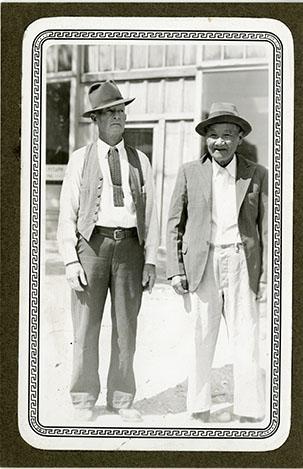
Traveling by train in Yuma with a box of bones in his hands, G.W. Chapman did what many believed to be sacrilegious. He dumped a huge box filled with dead Chinese immigrants’ bones into the Colorado River.
It was a warm day in 1882, and “Old Chap,” Tombstone’s express messenger and mail clerk, had promised their families that he would fulfill the cultural tradition of returning the bones to their homeland.
His violation of the cultural tradition was one of many incidents across Arizona in which the Chinese were treated as second-class citizens.
The Chinese first came to the United States in large numbers in the 19th century and helped modernize America by building railroads. Their customs and lifestyle unsettled whites, who used the power of legislation and general hate to discriminate against the Chinese.
On the day, Chapman could care less about tradition. Upon returning to Tombstone, he lost his job but his misdeeds later paid off. He ran for Tombstone’s city assessor, and the local paper said the bone-dumping insulted Chinese residents in the area. He took little time to reply with an insensitive remark: “‘Yes, I did dump the damn Chinamen into the river; and if I had it to do over again, I would throw every damn Chinaman, alive or dead, into the Colorado River that came into Arizona.’”
He won the largest majority of anyone in Tombstone’s history.
Tombstone’s historian emeritus, Ben Traywick’s, said Old Chap’s story was one of many incidents in historical record documenting racism against the Chinese.
Contrary to what people might believe, racism was not just reserved for African-Americans, Native Americans and Hispanics.
The great influx of the Chinese — many more men than women — arrived in the Tucson area in the 1880s, with the building of the Southern Pacific Railroad, according to Julia Arriola, a museum curator at the Arizona History Museum.
The Chinese worked for low wages, according to Arriola and were also willing to do high-risk jobs such as railroad construction. They made progress in conforming to the ways of the western frontier and despite being segregated, they adjusted to an American lifestyle, Lawrence Michael Fong wrote in a 1980 article in The Journal of Arizona History.
Despite this, the Chinese were still met with opposition.
On a national scale, the Chinese Exclusion Act of 1882 allowed for the rejection of everyone from the country except diplomats, who were required to have a certificate from their government. This act expired in 1892 but was extended for another 10 years by the Geary Act of 1892, according to Fong.
In Arizona, the Miscegenation Law of 1901 prohibited Chinese immigrants from marrying anyone outside of their own race.
Racial hostility against the Chinese often barred them from taking any jobs in mining and manufacturing, and they were forced to take jobs in restaurants, farming and laundries, Andrea Pugsley wrote in a 2003 article in The Journal of Arizona History.

Traywick described many Chinese small businesses, including the Bird Cage Laundry run by Sam Hing. Another, Yee Yee, who had six fingers on each hand, also had a laundry in the town.
Quong Gee Kee ran a Tombstone restaurant called the “Can-Can,” which served breakfast consisting of “steak and potatoes, ham and beans, and frequently eggs and coffee,” wrote Traywick.
Although the Chinese established themselves in the community, the negative sentiment toward them was still present.
“They were shunned quite a bit because they looked totally different, with a totally different language and they dressed differently,” Arriola said.
The Chinese believed that “peach blossoms brought long life and that white narcissus flowers” meant good fortune, Traywick wrote. Whites could not wrap their heads around the fact that Chinese men liked the practice of bound feet on their women.
Traywick wrote that Tombstone’s Chinese kept to themselves and were very frugal. “They spent nothing except for the bare necessities of life,” he wrote. Furthermore, when they would spend the money, it would go to other Chinese. This practice brewed resentment against them.
Other Arizona towns campaigned against the Chinese, including Jerome, where newspaper editors complained that immigrants didn’t support local businesses, according to Kathryn Reisdorfer in a 2003 article in The Journal of Arizona History.
Bill Adams, the editor in Jerome, wrote that “25 or 35 Chinamen residing in Jerome do not purchase as much wearing apparel in Jerome as any three white men living here.” The editor predicted that if the Chinese left Jerome, “it would leave room for at least 50 white people who would spend their money at home, thus increasing local business to a great extent.”
Such anti-immigrant rhetoric led to many Chinese fleeing Arizona.
But not all left. A woman named China Mary lived in Tombstone until she died.
“She was the absolute ruler of Tombstone’s Hoptown (Chinese section of Tombstone) and all its denizens, not only ruled them but virtually owned them body, life, and soul,” Traywick wrote, “Her word and her decisions were undisputed law, and none dared disobey.”
It was very unusual for a woman to have a position like that in the American West, but even more so for China Mary because she was Chinese.
Most of the cooking, washing, yard work and housework were by Chinese labor in Tombstone, and the town realized that “no Oriental could be hired for any job except through China Mary,” Traywick wrote.
The Chinese didn’t want to talk to whites. China Mary “didn’t associate with non-Chinese. I don’t think any of them did,” Traywick wrote.
If anyone in town wanted to hire a servant, maid, laundress, even a Chinese prostitute, they had to go through China Mary to bargain, wrote Traywick. She guaranteed the workers’ honesty and willingness to work, and made sure that their job was satisfactory.
China Mary also acted as a supplier to all of the opium dens and the red-light girls, according to Traywick.
She had influence over multiple businesses in Tombstone and was well-liked and respected by most of the people. Traywick wrote that China Mary never turned away people who were sick, injured or hungry.
Upon her death, China Mary was one of the few Chinese of Tombstone who chose to be buried at Boothill, instead of being sent back to China.

According to Traywick, the Chinese had freedom in Tombstone because they had money, kept to themselves and defended themselves when the town tried to push them out.
“I’m sure if I was there (at that time), I would’ve been friends with them,” Traywick said.
Despite all the hate toward them, some Chinese endured within Arizona.
They continued to grow into the merchant business as grocery stores and markets. In Tucson, according to Arriola, there were 70 Chinese operated grocery stores in 1908, and that number grew to 114 stores in 1950.
They set up in primarily Mexican neighborhoods and sold produce in the streets, going around in rickety wagons, said Arriola.
The father of Allen Lew started a grocery store in Tucson in the 1940s called “Joe’s Super Market” on Main Street. Today, Allen Lew is president of the Tucson Chinese Association.
“It was a fairly small store and you didn’t have to sell a lot because there weren’t as many options then,” Lew said.
Patsy Lee, 65, a retired teacher at Tucson Unified School District, also had a father who opened up his own market in Tucson around 1949 called “Alan’s Market.” Both Lew and Lee said that the Chinese markets were lucrative at the time because they would allow credit for families who couldn’t afford groceries right at that moment.
“We helped these people and helped their families to survive,” Lew said.
In the 1950s and ’60s, as Lee was growing up, she said discrimination against the Chinese was not as blatant, but rather subtle. “Asians are the white man’s favorite minority group,” she said.
Deborah Lee is a reporter for Arizona Sonora News, a service from the School of Journalism with the University of Arizona. Contact her at [email protected]
Click here for a Word version of this story and high-resolution photos.







